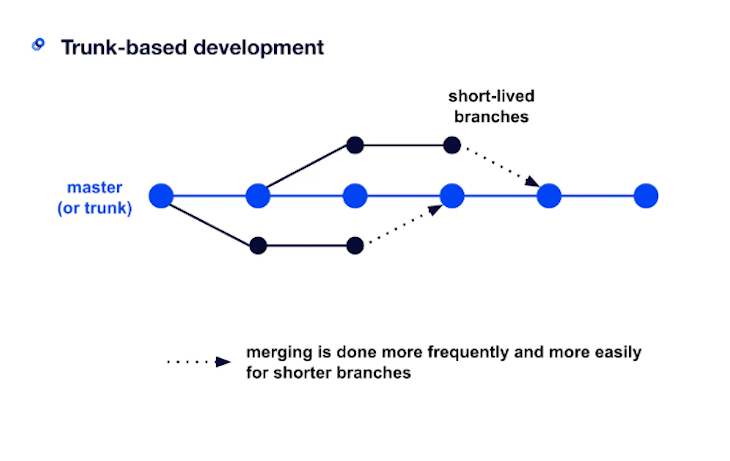Trunk-based development first emerged in the early days of version control systems and agile methodologies. The term gained prominence with the advent of distributed version control systems such as Git. Similar to agile, trunk-based development emphasizes the continuous delivery of a working software.

As a product manager, implementing trunk-based development into your software development life cycle enables you to reduce complexity and achieve faster time to market.
In this article, you will learn what trunk-based development is, its key principles and practices, and the challenges that may emerge.
Trunk-based development is an approach to software development where developers frequently integrate their code changes into a shared main branch, called the trunk or mainline, instead of working on long-lived feature branches:

Trunk-based development offers several benefits that contribute to improved software development practices. Here are some key advantages:
Overall trunk-based development offers benefits such as faster feedback, improved collaboration, reduced code complexity, agility, faster time to market, and support for continuous delivery and DevOps practices.
Trunk-based development adheres to several key principles and practices that guide its implementation. The following are important to keep in mind:
These principles and practices help teams to deliver high-quality products, respond to changing requirements, and promote collaboration, agility, and faster feedback cycles.
Below are some examples of companies that have embraced trunk-based development:
Google is known for its focus on speed and innovation in development practices. To support this, Google has integrated trunk-based development as a key component in its development approach.
With a vast codebase and numerous engineers, Google prioritizes integrating code changes into the main branch to ensure CI and swift feedback loops. This enables Google to provide product updates quickly while maintaining a scalable and reliable infrastructure.
Spotify has also adopted trunk-based development. The teams at Spotify use brief-lived branches and frequently merge their modifications into the main system.
With this approach, Spotify can consistently introduce new features and enhancements to its platform, quickly respond to user feedback, and maintain high innovation.
At Facebook, development teams make small, concentrated changes that they frequently integrate into the mainline. This technique enables them to continually enhance their platform, experiment with new features, and maintain excellent stability and performance.
Atlassian advocates for trunk-based development in its development practices. This approach allows teams to collaborate, integrate changes frequently, and swiftly deliver new features and bug fixes. Trunk-based development aligns with Atlassian’s agile and customer-centric approach to building products.
When adopting a trunk, teams may encounter certain challenges and need to consider several aspects. The most challenges and considerations come from:
When multiple developers work on the same code areas, integrating their work can lead to conflicts. To avoid this, teams should establish clear communication channels and have effective strategies to resolve conflicts, such as conducting regular code reviews.
Teams need a thorough testing process covering unit, integration, and regression tests to validate code changes properly. To overcome this, investing in automated testing frameworks, creating quality assurance processes, and regularly monitoring the codebase quality is recommended.
Implementing feature toggles introduces additional complexity in managing different feature states and configurations. Teams need a robust toggles management system, ensuring proper configuration, monitoring, and control of feature flags.
Team members must have strong collaboration and communication skills to have frequent integration. This includes effective communication, coordinating work, and staying informed on the mainline’s status. Teams can establish guidelines for code reviews, hold regular sync-ups, and use collaboration tools to facilitate effective communication and teamwork.
Switching to trunk-based development can be a challenge for teams who are used to using long-lived feature branches or other development practices. Investing in training and supporting developers during the learning curve is important to make the transition smoother. This will help ensure the successful adoption of the trunk-based approach.
When code changes are integrated and deployed faster, there is a risk of introducing bugs or regressions into the production environment. To prevent this, teams should implement strong strategies such as monitoring and alerting mechanisms and effective feature rollback processes.
The tools and resources required for implementation may vary depending on your team’s preferences, development stack, and organizational context. That said, that following are frequently utilized:
Remember to evaluate the specific needs of your team and project and choose the tools and resources that best fit your requirements.
Trunk-based development promotes collaboration, agility, and faster delivery of high-quality software. By following this approach, you can iterate rapidly, respond to market needs, and maintain a codebase that is easier to manage and enhance over time. Trunk aligns well with modern software development practices, enabling teams to work together effectively.
Featured image source: IconScout

LogRocket identifies friction points in the user experience so you can make informed decisions about product and design changes that must happen to hit your goals.
With LogRocket, you can understand the scope of the issues affecting your product and prioritize the changes that need to be made. LogRocket simplifies workflows by allowing Engineering, Product, UX, and Design teams to work from the same data as you, eliminating any confusion about what needs to be done.
Get your teams on the same page — try LogRocket today.

A practical five minute revenue estimation method to help product managers compare ideas, drop low impact features, and prioritize smarter.

A practical guide for PMs who want to stop being bottlenecks, delegate smarter, and lead teams effectively with a clear ownership framework.

Stop letting unreliable data block features. Treat data as inventory to track quality, ownership, and ship with confidence.

Learn why slide decks slow teams down and explore better tools like whiteboards, PRDs, and prototypes to improve collaboration and alignment.